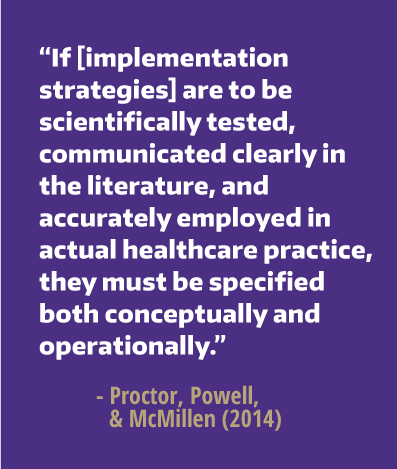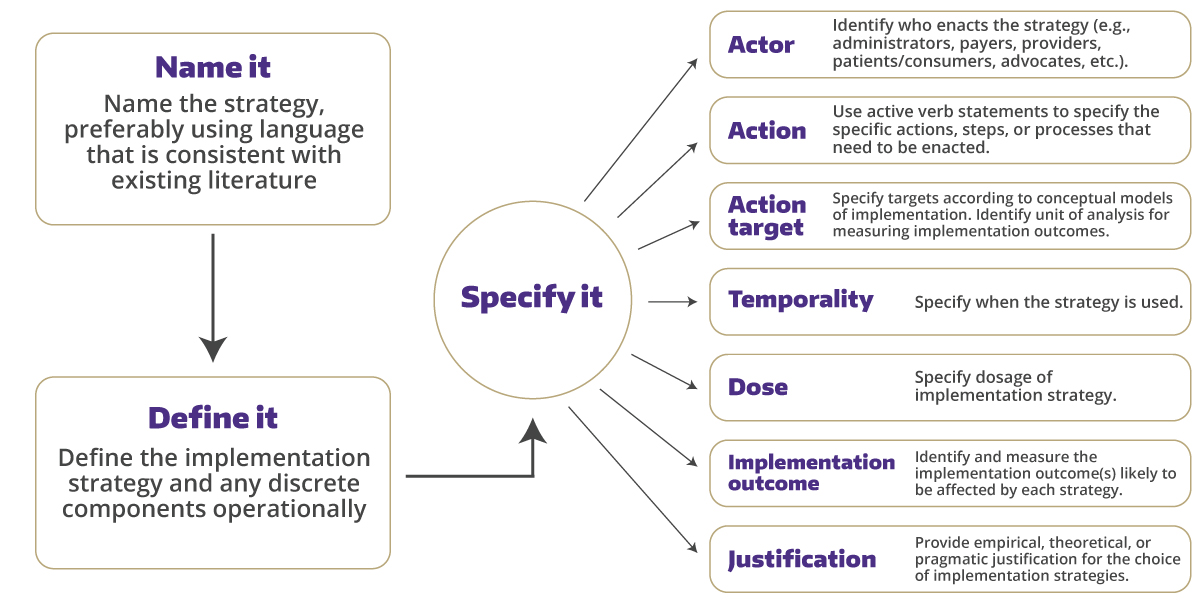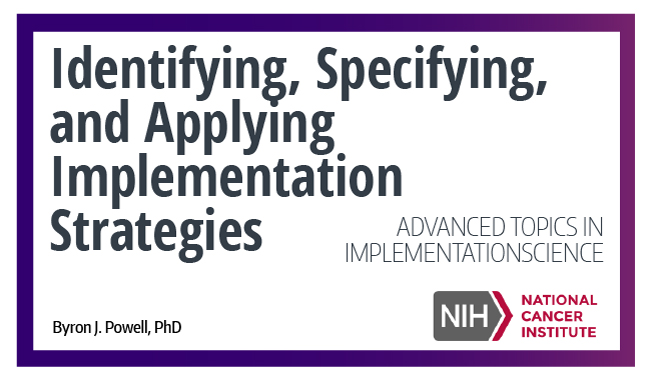
What is an implementation strategy?
Implementation science is fundamentally concerned with identifying effective strategies for implementing evidence-based interventions. Therefore it is critical to understand the difference in what is meant by implementation strategies and evidence based interventions.
Implementation strategies are the actions taken to enhance adoption, implementation, and sustainability of evidence based interventions.
Evidence based interventions are programs, practices, principles, procedures, products, pills, or policies that have been demonstrated to improve health behaviors, health outcomes, or health-related environments.
Evidence based interventions are the what that is being implemented. Implementation strategies are how we seek to get evidence based interventions into normal practice in clinical or community settings. This distinction between “what” and “how” is useful for distinguishing implementation strategies from evidence based interventions.
For an in-depth explanation of implementation strategies, read Kirchner and colleagues' excellent introduction in Psychiatry Research (2019).

Examples of implementation strategies
Implementation strategies can target determinants at any level of the social ecological model. Implementation strategies can be a single strategy (e.g. training), or a bundle of strategies to address multiple implementation barriers (e.g. the use of both reminders and role revisions), or blended strategies that are multiple strategies packaged and branded for use (e.g. the Leadership and Organizational Change Intervention).
In 2015, the Expert Recommendations for Implementing Change (ERIC) project published a refined compilation of implementation strategy terms and definitions compiled by systematically gathering input from stakeholders across implementation science and clinical practice. The resulting table of 73 implementation strategies can be found here or in the original Open Access (✪) article in the journal Implementation Science.
Waltz and colleagues then used concept mapping to characterize relationships among the 73 implementation strategies and assess their feasibility and importance, resulting in nine clusters of implementation strategies. While not exhaustive, the figure below provides examples of the different strategies found in each of the nine distinct clusters.
![Examples-of-implementation-strategies[66] A chart titled: A SELECTION OF IMPLEMENTATION STRATEGIES. Nine strategy groups are presented, each group in its own bubble. Each bubble is labeled with the grouping using white text on a purple background, and each bubble also has three example strategies (bulleted black text on white background). Groupings are: 1. “Use evaluative and iterative strategies.” Examples: Assess for readiness and identify barriers and facilitators; Audit and provide feedback; Purposefully reexamine the implementation. 2. “Adapt and tailor to context.” Examples: Tailor strategies; Promote adaptability; Use data experts. 3. “Train and educate stakeholders.” Examples: Conduct ongoing training; Distribute educational materials; Use train-the-trainer techniques. 4. “Engage consumers.” Examples: Increase demand; Use mass media; Involve patients/consumers and family members. 5. “Change infrastructure.” Examples: Mandate change; Change record systems; Change physical structure and equipment. 6. “Provide interactive assistance.” Examples: Facilitation; Provide local technical assistance; Provide clinical supervision. 7. “Develop stakeholder interrelationships.” Examples: Identify and prepare champions; Organize clinician implementation team meetings; Identify early adopters. 8. “Support clinicians.” Examples: Remind clinicians; Revise professional roles; Facilitate relay of clinical data to providers. 9. “Utilize financial strategies.” Examples: Alter incentive/allowance structures; Access new funding; Fund and contract for the clinical innovation.](https://impsciuw.org/wp-content/uploads/2022/07/Examples-of-implementation-strategies66-scaled.jpg)
Adapted from: ✪ Waltz, TJ., Powell, BJ., Matthieu, MM. et al. Use of concept mapping to .... Implementation Sci 10, 109 (2015) doi:10.1186/s13012-015-0295-0
Specifying and Reporting Implementation Strategies for Replicability

Adapted from Proctor EK, Powell BJ, McMillen JC. Implementation strategies: Recommendations for specifying and reporting. Implement Sci. 2013;8(139).
Open Access articles will be marked with ✪
Please note some journals will require subscriptions to access a linked article.
Learn More:
- ✪ What is the extent and quality of documentation and reporting of fidelity to implementation strategies: a scoping review (Implementation Science, 2015)
- Reducing research waste with implementation laboratories (The Lancet, 2016)
- ✪ Beyond “implementation strategies”: classifying the full range of strategies used in implementation science and practice (Implementation Science, 2017)
- Methods to Improve the Selection and Tailoring of Implementation Strategies (The Journal of Behavioral Health Services & Research, 2017)
- Assessing Implementation Strategy Reporting in the Mental Health Literature: A Narrative Review (Administration and Policy in Mental Health and Mental Health Services Research, 2019)
WATCH:
- A Compilation of Strategies for Implementing Clinical Innovations in Health and Mental Health (Medical Care Research and Review, 2012)
- ✪ Use of concept mapping to characterize relationships among implementation strategies and assess their feasibility and importance: results from the Expert Recommendations for Implementing Change (ERIC) study (Implementation Science, 2015)
- ✪ Choosing implementation strategies to address contextual barriers: diversity in recommendations and future directions (Implementation Science, 2019)
- Adapting a Compilation of Implementation Strategies to Advance School-Based Implementation Research and Practice (Prevention Science, 2019)
